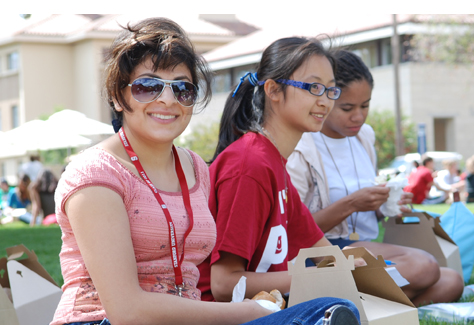
Because undergraduate life is based in University residences, Stanford requires new and first-year transfer students to live on campus where they can more easily meet new friends and participate in residential community activities.
First-year students who accept their offer of admission receive information and preference forms for housing, academics, and student services in the “Approaching Stanford” guidebook. Stanford sends the guidebook in May. Preference forms for housing, meal plan, required classes, and advising are due by mid-June.
Students who require special housing accommodations due to documented medical issues must submit paperwork to the Office of Accessible Education (OAE) by the Approaching Stanford application deadline.
Non-traditional freshmen who need to be located in Graduate Housing (students 25 or over, students requiring couples housing, or students with children) need to apply for housing by turning in a paper application to the Housing Assignments office in addition to filling out the Approaching Stanford forms. Please note that the deadline to turn in a Graduate housing application is in early July. Non-traditional freshmen will be provided an affiliation with a freshman house.
Student Housing makes freshmen and transfer assignments in random order – not on a first-come, first-served basis – after the deadline for returning forms has passed.
Housing Assignments announces building assignments in early August. Though Stanford cannot guarantee a particular housing assignment, about 60 percent of freshmen are assigned to their first-choice housing type. New students receive their roommate information when they arrive on campus.
Living on Campus
Stanford University has been a residential teaching and research university from its beginning, and its residence system is among the largest and most diverse in the nation.
More than 6,000 undergraduate students (96 percent) call Stanford Student Housing home.
Stanford’s vibrant residence communities give students the opportunity to extend learning beyond the classroom, make lifelong friends, relax and hang out, and develop a deeper understanding of the world beyond the University.
All freshmen are guaranteed four complete or partial years of campus housing, and transfer students are guaranteed three complete or partial years.
Stanford’s Residential Education Program
The Residential Education (Res Ed) program is based on Stanford’s belief that formal teaching, informal learning, and personal support in residences are fundamental components of a Stanford education – essential for preparing students for a life of leadership, intellectual engagement, citizenship, and service.
Res Ed programs complement the academic curriculum with activities and experiences that build strong, pluralistic communities. They give students opportunities to learn from each other, from faculty and staff members, and from visiting diplomats, artists, and scholars. Popular house activities include:
- Faculty dinners
- Lectures, mini-courses, and study groups
- International holiday celebrations
- Weekly current events discussions
- Poetry readings
- House drama productions
- Outings to community events
- Film screenings
- Intramural athletics
- Trips to San Francisco, Lake Tahoe, Yosemite, and other locations
Residential Education begins with the Resident Fellows, faculty or senior staff members who live in residence halls with their families and help provide a warm and intellectually stimulating environment.
Residence staff also includes Stanford sophomores, juniors, and seniors who offer personal and academic counseling. These staff roles include Resident Assistants (RA's), Peer Health Educators (PHE's), Residence Computer Consultants (RCC's), and others depending on the type of house.
Much of the education in the residences is informal and occurs as naturally as conversations at home over the dinner table or in front of the TV. The difference in living at Stanford is that students with widely-ranging interests, backgrounds, talents, and perspectives are living together, making all kinds of activities and conversations possible.
Residential education in all its forms is one of the reasons that, despite the University’s size and breadth of resources, Stanford remains an intimate community.
Freshmen and Transfer Residences
Undergraduate residences vary greatly in program, size (from 30 to 300 students), age, style of architecture, and layout of rooms and common areas. All, however, are located around the campus within a ten-minute walking distance of classrooms.
Freshmen
All freshmen live in coeducational residence halls or houses. Rooms are single gender.
If you are a freshman, you may request assignment to:
- An all-frosh house or a four-class house (housing freshmen, sophomores, juniors, and seniors)
- A house with men and women living on the same floor or a house with men and women living on separate floors
- A cross-cultural theme house: Muwekma-tah-ruk (Native American), Okada (Asian American), Ujamaa (African American), or Casa Zapata (Chicano/Latino). Cross-cultural theme houses are open to all students and provide educational and social activities that explore the history and culture of a particular ethnic group.
- ILE's (Integrated Learning Environments): SLE (Structured Liberal Education), Italic (Arts focus). See the Approaching Stanford Handbook for more information about these programs.
- Freshmen-Sophomore College (FroSoCo). See the Approaching Stanford Handbook for more information about this program.
Freshmen may not express a preference for a specific hall (such as Wilbur or Roble).
Transfer Students
To facilitate a sense of community, Stanford assigns transfer students to residence halls or houses that include other transfer students.
Transfer students are assigned to upper-class houses (housing sophomores, juniors and seniors) with coed floors unless they are non-traditional students (students 25 or over, students requiring couples housing, or students with children) in which case they are assigned to Graduate Housing.
After Your First Year
After your first year living at Stanford, you can choose from Stanford’s 78 undergraduate buildings, which include a wide variety of themes and focuses.
Continuing students are assigned to housing based on a lottery system called The Draw.
